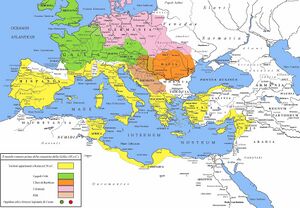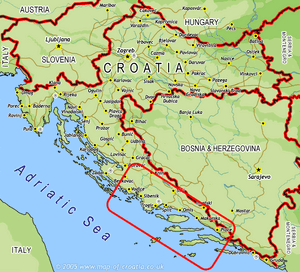Dalmatia
| Author:Laxman Burdak, IFS (R) |


Dalmatia (डालमासिया) is an historical region of Croatia on the eastern coast of the Adriatic Sea, alongside Croatia proper, Slavonia, and Istria.
Variants
Origin of name
The name Dalmatia derives from the name of the Dalmatae tribe, which is connected with the Illyrian word delme ("sheep").[1]
Location
Dalmatia is a narrow belt of the east shore of the Adriatic Sea, stretching from the island of Rab in the north to the Bay of Kotor in the south. The Dalmatian Hinterland ranges in width from fifty kilometres in the north, to just a few kilometres in the south; it is mostly covered by the rugged Dinaric Alps. Seventy-nine islands (and about 500 islets) run parallel to the coast, the largest (in Dalmatia) being Brač, Pag, and Hvar. The largest city is Split, followed by Zadar and Šibenik.
History
Dalmatia's name is derived from the name of an Illyrian tribe called the Dalmatae who lived in the area of the eastern Adriatic coast in the 1st millennium BC. It was part of the Illyrian Kingdom between the 4th century BC and the Illyrian Wars (220, 168 BC) when the Roman Republic established its protectorate south of the river Neretva.
By the 4th century BC the Celts had penetrated into the Balkans, coming into contact with the Thracians, Macedonians and Greeks.[2] In 380 BC they fought in the southern regions of Dalmatia (present day Croatia), and rumors circulated around the ancient world that Alexander the Great's father, Philip II of Macedonia had been assassinated by a dagger of Celtic origins.[3][4]
The name "Dalmatia" was in use probably from the second half of the 2nd century BC and certainly from the first half of the 1st century BC, defining a coastal area of the eastern Adriatic between the Krka and Neretva rivers.[5] It was slowly incorporated into Roman possessions until the Roman province of Illyricum was formally established around 32–27 BC. In 9 AD the Dalmatians raised the last in a series of revolts[6] together with the Pannonians, but it was finally crushed and, in 10 AD, Illyricum was split into two provinces, Pannonia and Dalmatia, which spread into larger area inland to cover all of the Dinaric Alps and most of the eastern Adriatic coast.[7]
The collapse of the Western Roman Empire, with the beginning of the Migration Period, left the region subject to Gothic rulers, Odoacer and Theodoric the Great. They ruled Dalmatia from 480 to 535 AD, when it was restored to the Eastern (Byzantine) Empire by Justinian I.
The historian Theodor Mommsen wrote in his book, The Provinces of the Roman Empire, that all Dalmatia was fully romanized by the 4th century AD. However, analysis of archaeological material from that period has shown that the process of Romanization was rather selective. While urban centers, both coastal and inland, were almost completely romanized, the situation in the countryside was completely different. Despite the Illyrians being subject to a strong process of acculturation, they continued to speak their native language, worship their own gods and traditions, and follow their own social-political tribal organization which was adapted to Roman administration and political structure only in some necessities.[8]
After the medieval Kingdom of Croatia entered a personal union with Hungary in 1102, its cities and lands were often conquered by, or switched allegiance to, the kingdoms of the region during the Middle Ages. At one time, most of Dalmatia came under rule of the Republic of Venice, which controlled most of Dalmatia between 1420 and 1797, with the exception of the small but stable Republic of Ragusa (1358–1808) in the south. Between 1815 and 1918, it was a province of the Austrian Empire known as the Kingdom of Dalmatia. After the Austro-Hungarian defeat in the World War I, Dalmatia was split between the Kingdom of Serbs, Croats and Slovenes, which controlled most of it, and the Kingdom of Italy, which held several smaller parts. After World War II, the People's Republic of Croatia as a part of Yugoslavia took complete control over the area. Following the dissolution of Yugoslavia, Dalmatia became part of the Republic of Croatia.
Dalmatae
The Delmatae, alternatively Dalmatae during the Roman period, were a group of Illyrian tribes in Dalmatia, contemporary southern Croatia and western Bosnia and Herzegovina. The region of Dalmatia takes its name from the tribe.
The Delmatae appear in historical record for the first time in 181 BC, when upon the death of their ruler Pleuratus III of the Illyrian kingdom, they refused to accept the rule of his son, Gentius and seceded. They expanded and came to include coastal Illyrian tribes like the Tariotes, the Hylli and the Nesti and increased their territory to the north against the Liburni. Conflict with Roman expansionism and its local allies in the eastern Adriatic began in 156-55 BC. The Roman–Dalmatae Wars lasted until 33 BC when Octavian (the later Emperor Augustus) installed Roman hegemony in Dalmatia. Local instability and minor rebellions continued in the province of Dalmatia and culminated in the Great Illyrian Revolt in Dalmatia and closely linked Pannonia in 6 AD. The revolt, which lasted for three years, involved more than half a million combatants, auxiliaries and civilians on both side. In the aftermath, some Delmataean communities were relocated in the northern Sandzak region and others were resettled in parts of Carinthia to provide labor for the Roman mines. The defeat of the revolt began the integration of Dalmatia which in turn led to the romanization of the region by the early Middle Ages.
Jat History
- Jaton - city in Dalmatia.[9]
- Žut - "the yellow one", is an uninhabited island in the Croatian part of the Adriatic Sea, in central Dalmatia.
Notable persons
External links
See also
- Dalmas (डालमास) is a village in Laxmangarh tehsil in Sikar district in Rajasthan. What can be the relation with Dalmatia?
References
- ↑ Wilkes, John (1995). The Illyrians. The Peoples of Europe. Wiley-Blackwell. p. 244. ISBN 0-631-19807-5.
- ↑ See The Periplus of Scylax (18-19)
- ↑ See Diod. 16, 94, 3
- ↑ Moscati, Sabatino; Grassi, Palazzo (1999). "4: Ancient Literary Sources". The Celts. Random House Incorporated. ISBN 978-0-8478-2193-8.
- ↑ S.Čače, Ime Dalmacije u 2. i 1. st. prije Krista, Radovi Filozofskog fakulteta u Zadru, godište 40 za 2001. Zadar, 2003, pp. 29, 45.
- ↑ Charles George Herbermann, The Catholic Encyclopedia: An International Work of Reference (1913)
- ↑ M.Zaninović, Ilirsko pleme Delmati, pp. 58, 83-84.
- ↑ A. Stipčević, Iliri, Školska knjiga Zagreb, 1974, p. 70
- ↑ Mangal Sen Jindal (1992) : History of Origin of Some Clans in India/Jat From Jutland/Jats, their Different Names,p.2
Back to Europe

